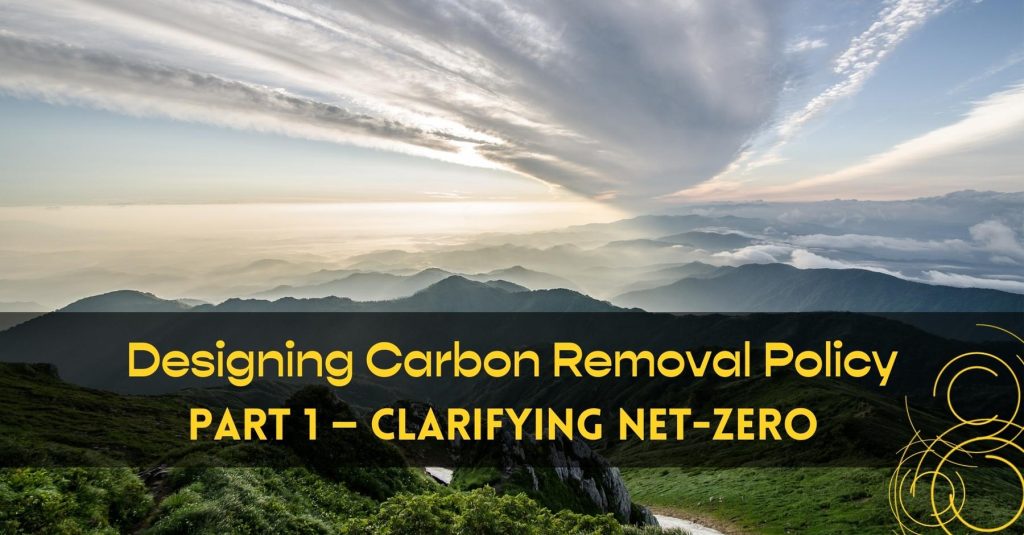
The Paris Agreement and subsequent IPCC Special Report on 1.5°C have motivated nations and corporates to take on net-zero targets. We have arrived in a new era of climate policy. Next to reducing emissions, this progress has sparked immense interest in carbon removal — the other part of climate change mitigation. Next to steep emission reductions required over the coming decades, carbon removal will become the main driver of climate ambition before mid-century.
To date, the focus of climate policy has almost exclusively been on cutting emissions. When it comes to policy tools and incentives, we have learned what works and what doesn’t. To make the net-zero-to-net-negative pathway a reality, there is a pressing need to establish carbon removal policies that deliver negative emissions. The European Union is leading the way.
Residual emissions challenge
When designing policies to cut emissions, the end goal is clear — reducing emissions as close to zero as possible. However, in some sectors, for example in agriculture and aviation, reducing emissions to zero is not feasible. That is because there are either no decarbonisation solutions available, these solutions are not available at the scale needed and/or are prohibitively expensive, or emissions are unavoidable from a social justice perspective.
As a result, we use net-zero targets instead of zero-emission targets and rely on carbon removal to (1) balance out residual emissions to get to net-zero, (2) remove legacy emissions from the atmosphere to achieve net-negative emissions thereafter, and (3) compensate for an overshoot of emissions if needed.
The problem — there is no clarity on what residual emissions are. This concept, sometimes also referred to as unavoidable emissions, hard-to-abate emissions, difficult-to-abate emissions or impossible-to-abate emissions, does not have an agreed definition. This leads to interpretations that seem more like inconvenient(expensive)-to-abate emissions in practice, especially in climate modelling, where the focus tends to be on what is cheap to decarbonise.
The lack of shared understanding of residual emissions, among other challenges, translates into widely different estimations of how much annual carbon removal is needed by mid-century. The IPCC Special Report on 1.5°C suggests the range of 5–20 billion tonnes of carbon removal. The CDR Primer, in comparison, offers a modest 1.5–3.1 billion tonnes. The most commonly referred range is 5–10 billion tonnes. While indicating a pressing need to start scaling up carbon removal today, this significant uncertainty poses a challenge for designing carbon removal policies.
Here is a three-step guide to getting started.
1. Clarify Net-zero Target
To prepare an impactful carbon removal policy, the following two elements of net-zero targets need to be explained in detail.
a) Define residual emissions and allocate residual emissions budget
A residual emissions budget explains which sectors of the economy need to deliver emission reductions — helping to clarify it also on a company level. It outlines whose emissions are unavoidable and to which extent. The national net-zero goals often don’t get specific enough to inform carbon removal policies and drive necessary investments. This fuels the discrepancy between how countries and corporations approach their net-zero targets, especially regarding the use of carbon removal.
b) Specify the contributions of all greenhouse gases separately
Long-lived greenhouse gases like carbon dioxide, and short-lived greenhouse gases like methane, have a different impact on global warming. For short-lived greenhouses gases, carbon removal more than balances the emissions. The emission profiles of countries are very different, for example, those with substantial agricultural sectors and high methane emissions might need slightly less carbon removal.
2. Establish Separate Targets
One of the main questions around designing a carbon removal policy is how to address the “moral hazard” problem where the availability of carbon removal could reduce the urgency to cut emissions. Establishing separate targets for emission reductions and carbon removal is an obvious and by now recognised solution to address the potential competition between emission reductions and removals.
However, separate targets, while very helpful, are just a starting point. What matters is how these targets are implemented in practice. All the policies, regulations, and incentives need to enforce these targets in practice. A case in point is the role of carbon removal in carbon markets. For example, the European Union has adopted separate climate targets in the Climate Law. The actual implementation of these targets is delivered by a range of legislative initiatives in the FitFor55 package where proposals are currently in the negotiation phase. Carbon removal is part of ongoing discussions in several legislative files, all the while some of the key elements of the picture, namely the proposal for the Carbon Removal Certification Mechanism under Sustainable Carbon Cycles, will only come out at the end of 2022.
This brings us to the third step.
3. Prepare a Holistic Carbon Removal Strategy
This suggestion has not so far received much attention but has immense potential. A holistic carbon removal strategy is a tool that would provide the fundamental principles which inform all other policies and regulations on carbon removal, providing alignment and consistency. It can be a self-standing document or part of another strategy, for example, a national long term strategy.
Many sectors can deliver carbon removal (agriculture, forestry, industry), and there is a vast array of carbon removal approaches, ranging from soil carbon to direct air capture with carbon storage. Relying on bottom-up sectoral policies without an agreed uniform top-down strategy may result in a patchwork of inconsistent policies.
Some elements of carbon removal strategy could be:
• General implementation plan (which policies and regulations will be used and how, the role of institutions)
• Time table of scaling up removals
• The process to revise the carbon removal target in case of an emission overshoot
• Country’s contribution to carbon removal in the international context (developed countries need to do more)
• Sectors that deliver carbon removal
• Which emissions are eligible to be balanced with removals? Can fossil emissions be balanced with short-term removals?
• Guiding principles for accounting for carbon removal, addressing permanence, leakage, saturation
• Technology neutrality
• Incentives, finance, support for innovation, the role of carbon markets
• Just transition, climate justice, public participation
Such a three-step approach would prepare a solid foundation for designing impactful carbon removal policies, create a common understanding of the role of removals across stakeholders and provide long term certainty for private and public investments.
This is the first post in the “Designing Carbon Removal Policy” series. Two follow-up posts — Part 2 covering accounting challenges and Part 3 focusing on financing and incentivising — will follow.
Sign up for updates below and stay tuned!
***
Would you like to use (parts of) the text? Go ahead on the condition that you explicitly refer to this post and include a link.
Thank you!

